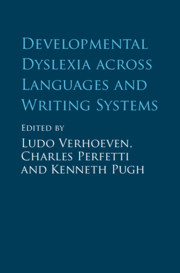Book contents
- Developmental Dyslexia across Languages and Writing Systems
- Developmental Dyslexia across Languages and Writing Systems
- Copyright page
- Contents
- Figures
- Tables
- Contributors
- 1 Introduction
- Part I Developmental Dyslexia across Languages and Writing Systems
- Part II Cross-Linguistic Perspectives on Developmental Dyslexia
- 11 Behavioral Precursors of Developmental Dyslexia
- 12 Neural Predictors of Developmental Dyslexia
- 13 Neurocognitive Markers of Developmental Dyslexia
- 14 Role of Visual Attention in Developmental Dyslexia
- 15 Morphological and Semantic Processing in Developmental Dyslexia
- 16 Modeling the Variability of Developmental Dyslexia
- 17 Modeling Developmental Dyslexia across Languages and Writing Systems
- 18 Etiology of Developmental Dyslexia
- 19 Intergenerational Transmission in Developmental Dyslexia
- Epilogue
- Index
- References
16 - Modeling the Variability of Developmental Dyslexia
from Part II - Cross-Linguistic Perspectives on Developmental Dyslexia
Published online by Cambridge University Press: 27 September 2019
- Developmental Dyslexia across Languages and Writing Systems
- Developmental Dyslexia across Languages and Writing Systems
- Copyright page
- Contents
- Figures
- Tables
- Contributors
- 1 Introduction
- Part I Developmental Dyslexia across Languages and Writing Systems
- Part II Cross-Linguistic Perspectives on Developmental Dyslexia
- 11 Behavioral Precursors of Developmental Dyslexia
- 12 Neural Predictors of Developmental Dyslexia
- 13 Neurocognitive Markers of Developmental Dyslexia
- 14 Role of Visual Attention in Developmental Dyslexia
- 15 Morphological and Semantic Processing in Developmental Dyslexia
- 16 Modeling the Variability of Developmental Dyslexia
- 17 Modeling Developmental Dyslexia across Languages and Writing Systems
- 18 Etiology of Developmental Dyslexia
- 19 Intergenerational Transmission in Developmental Dyslexia
- Epilogue
- Index
- References
Summary
Reading is a highly complex task that relies on the integration of visual, orthographic, phonological and semantic information. This complexity is clearly reflected in current computational models of reading (Coltheart et al., 2001; Harm & Seidenberg, 1999, 2004; Perry, Ziegler, & Zorzi, 2007, 2010; Plaut et al., 1996). These models specify the “ingredients” of the reading process in a precise and detailed fashion as they implement the units and computations that are necessary to go from the visual information to word recognition and word production. Such models make it possible to simulate real reading performance in terms of reading latencies (how long it takes to compute the pronunciation of a word or pseudoword) and reading accuracy (whether the output of the model is correct). Computational models are particularly well suited to helping us understand reading impairments, such as developmental or acquired dyslexia.
- Type
- Chapter
- Information
- Developmental Dyslexia across Languages and Writing Systems , pp. 350 - 371Publisher: Cambridge University PressPrint publication year: 2019
References
- 12
- Cited by



